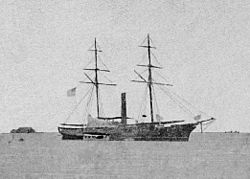Bombardment_of_Qui_Nhon
The bombardment of Qui Nhơn in 1861 was an attack by a United States Navy warship upon a Vietnamese-held fort protecting Qui Nhơn on the south central coast of Vietnam (modern-day Binh Dinh Province). United States forces under James F. Schenck went to southern Vietnam to search for missing American citizens but were met with cannon fire upon arriving. In response to the attack the American warship bombarded the fort until it was reduced. The incident occurred during French and Spanish conquest of southern Vietnam.[1]
